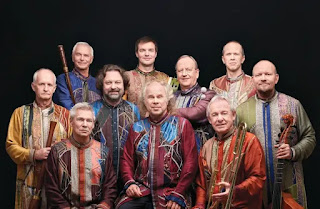 |
| Hortus Musicus (Pnina Even Tal) |
With the anniversary of J.S.Bach's
birth on March 21st, the Bach Festival is once again under way. Under the
auspices of the Jerusalem Baroque Orchestra and directed by JBO founder and artistic director David Shemer, Bach Festival VI opened with a three-day Baroque workshop for young musicians, topped
off by a concert performed by participants.
For "Schütz and his Contemporaries", held in the conference hall of the Jerusalem International YMCA on March 14th 2022, the JBO was joined by Hortus Musicus (Estonia) and its violinist/director Andres Mustonen, who conducted the concert. Hortus Musicus and Mustonen are no new faces to Israeli concert platforms, neither was this concert their first collaboration with the Jerusalem Baroque Orchestra. Prof. Shemer opened the evening's proceedings by making chronological order for the festival: early Baroque repertoire will be performed before concerts of Bach's music.
In his 'Historical
Description of the Noble Art of Singing and Playing' (1690), Wolfgang
Caspar-Printz described the “three famous S’s” - court music director of
Dresden Heinrich Schütz; Johann Hermann Schein, the choirmaster of Leipzig’s
St. Thomas Church and Samuel Scheidt, the music director from Halle – as “the
three best composers in Germany at this time”. They were close friends, working
and living in the same part of Germany. Indeed, Heinrich Schütz (1585-1672) has
frequently been referred to as the greatest German composer before Johann
Sebastian Bach. Following his early set of madrigals, almost all of the
Saxon-born’s known works are vocal settings of sacred texts, with or without
instruments (he received most of his training in Venice from Giovanni
Gabrieli); these works remain pivotal repertoire of Protestant church
music. Schütz' unique achievement was introducing into German music the new style
of the Italian monodists without creating an inferior hybrid style; his music
remained individual and German in feeling. At the Jerusalem concert, we heard a
number of his sacred motets, the vocal roles
performed by members of Hortus Musicus. One highlight was tenor Anto Õnnis'
singing of "Venite ad me", his performance of the multi-sectional
piece rich in timbre and dynamics and devotional in mood.
Johann Hermann
Schein was born within a year of both Schütz and Scheidt. Although
less in the limelight than Schütz, Schein (employed at the Thomasschule in
Leipzig) was one of the most illustrious predecessors of J. S. Bach. His
importance as a composer lies in the use he made of Italian monody and
concerted style in Lutheran church music. Although the majority of Schein's
output was vocal music, he is probably best known for the "Banchetto
Musicale" (1617) a collection of twenty instrumental "variation"
suites, all bearing an identical format. One of these suites made for a vibrant
opening work to the evening's program, with Hortus Musicus' fine band of early
winds (also the JBO's Alma Mayer-Nir) and percussion joining the JBO strings
and keyboard to colour the various sections with timbral variety and vigour.
(The instrumentation for these suites is not specified in the score.) While
some of Schein's sacred music uses the sophisticated techniques of the Italian
madrigal, Schein's secular music (for which he wrote all the words) includes
such genres as drinking songs of surprising simplicity and humour. With much
zest and witty banter, the Hortus Musicus singers' performance of songs
from the 1626 "Studenten-Schmaus" (Student Banquet) collection
suggested a focus more on drink than on banquet cuisine! In Samuel
Scheidt's canzon on "O Nachbar Roland", one of six large-scale
canzons from his "Ludi Musici" (1621) and based on a melody
popular in England, the composer had specified the use of viols, trombones,
bassoons and optional cornetts. An ideal piece for the Jerusalem concert's
joint ensemble, it provided plenty of opportunities for creative ensemble
playing, with a variety of timbres created by diverse instrumental combinations
producing constant differentiation of articulation and dynamics and giving the
performance a playful swing.
Another contemporary,
organist/organ technician Paul Peuerl was a German who spent his career in the
Austrian towns of Steyr and Horn. Most of his surviving music consists of
instrumental suites, free fantasies and a small number of texted Lieder with
serio-comic texts. Of the latter, we heard a hearty reading of "O
Musica" (1613).
'O Music, you noble
art,
Much praise is
lavished upon you,
For you bring great
pleasure and entertain us,
Renewing our sorrowful
lives.
Wherever you go, there
is great joy
with dancing, singing
and skipping.
Sadness rarely dwells
with you,
Our hearts are aflame
with joy.
O music, you noble
art!'
Probably the least
familiar of the composers representing early German Baroque music on this
program, Johannes Schultz, of whose life and work little is known, worked as an
organist in Dannenberg, Lower Saxony. He engaged in the writing of the ensemble
canzona, a genre less common in Germany than in Italy, of which we heard the
joint ensemble in two of contrasting character.
Michael Praetorius'
compositions also show the influence of Italian composers, as well as that of his younger
contemporary Heinrich Schütz. Concluding the concert was a suite from
"Terpsichore", Praetorius' sole surviving secular work (and the bread-and-butter
repertoire for many of us in our early music training.) If the collection of
over 300 dances takes its name from the muse of dance, Mustonen and the
instrumentalists certainly endorsed this heartily, with playing of much colour,
inspiration and energy. It is assumed that the collection was primarily
intended to be performed on violins, but here the addition of the
"buzzies" (of which there are too few players in Israel) certainly
added to the excitement and vitality of the performance, as Mustonen led the
players with relish and a sense of abandonment.
For Baroque music
aficionados, here was a fine opportunity to hear a representative collection of
early German Baroque works. An extra advantage was hearing them played in the
Jerusalem YMCA's conference hall, a space offering the audience closer
proximity with the artists and the music-making experience.

No comments:
Post a Comment